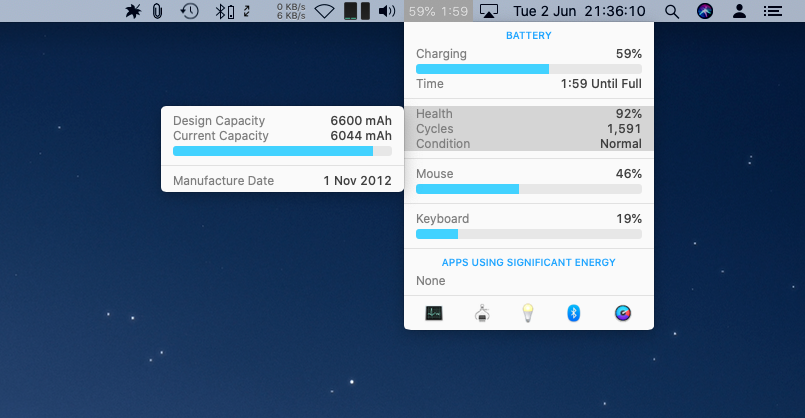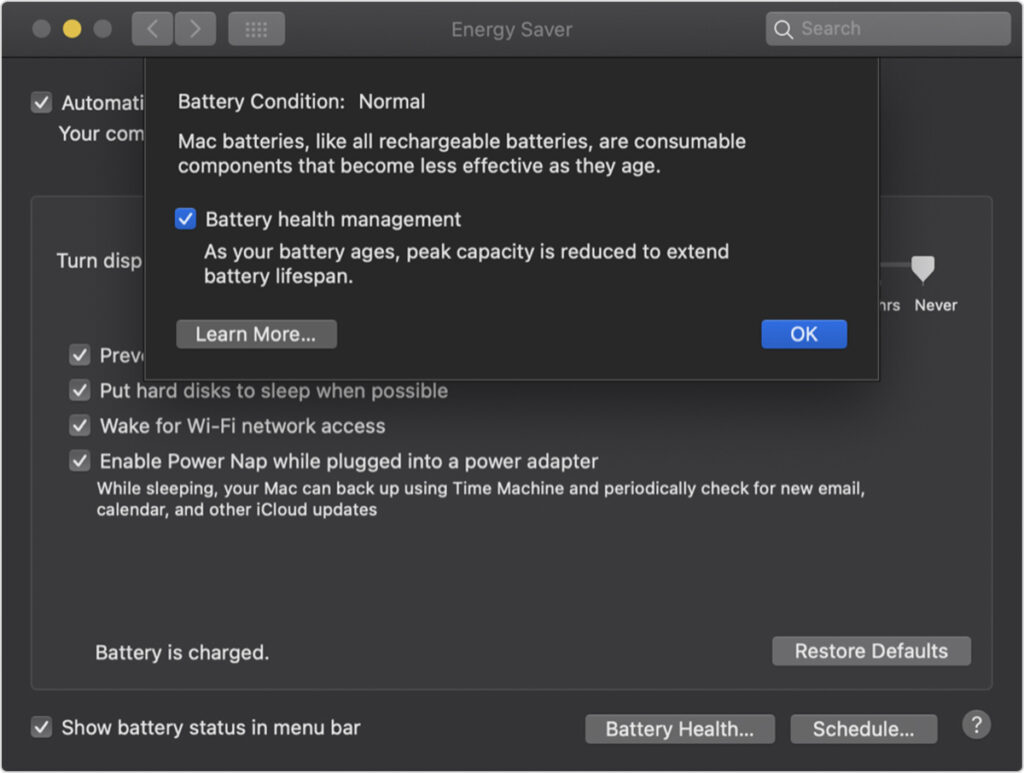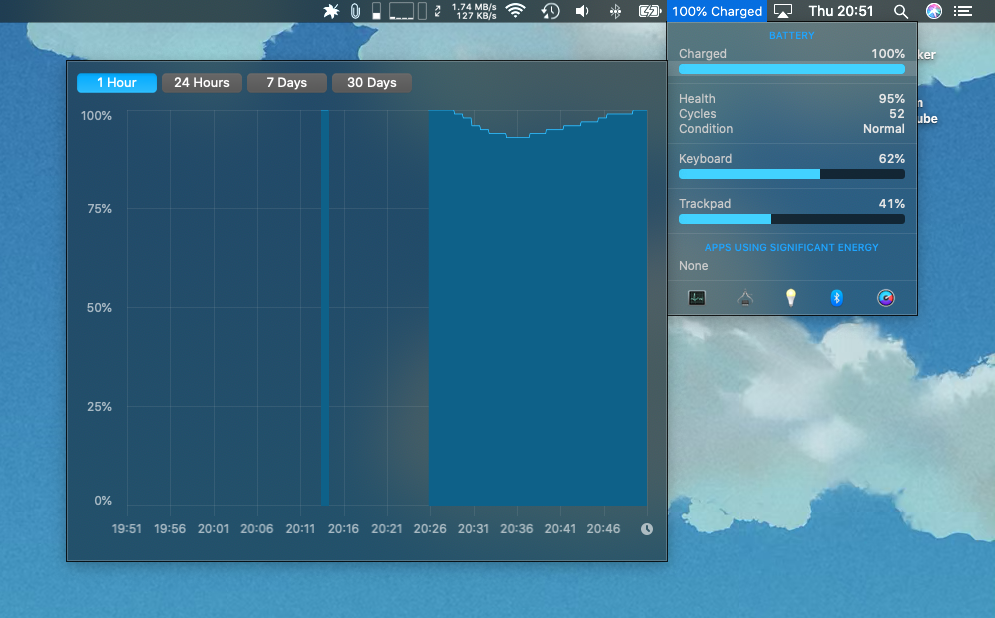With mobile devices becoming increasingly expensive and usually featuring non-replaceable batteries, it’s important that we treat them in a manner which extends their lifespan as much as possible. As an early adopter of mobile technology (and with many years of IT support under my belt) I wanted to share some basic techniques that have helped me get the most out of every rechargeable device I’ve worked with. I’m not saying you should do this and I don’t have scientific evidence to explain why my approach works, just years of getting more life out of laptops and mobile phones than most people. I’m also going to touch on a subject that’s troubling me as I’m contemplating my next laptop upgrade: the one-cable-for-everything philosophy. But first for some basics.

My Approach
As it was explained to me by an Apple store employee many years ago, battery cells are kind of like muscles, and degrade when they’re not exercised for long periods just as they can get damaged from over-use. In practice this means two things:
- Don’t leave a device plugged in and charging all of the time. This advice was more pertinent back in the day before intelligent chargers, but it still rings true today – batteries last longest when the juice keeps moving, and an eight hour day with some drain is better for a laptop battery than an eight hour day plugged in at 100%.
- Don’t make a habit of draining every last drop from a battery before charging. The chemical reaction needed to produce electricity takes a greater toll on the cell when it’s nearly empty, so you shouldn’t place high demands on your battery just as you shouldn’t exercise vigorously when your body needs rest. And, while it’s true that in the early days of nickel cadmium cells you had to flatten them once in a while to prevent a memory effect, this doesn’t apply to modern nickel metal-hydride cells.
I’ve adopted those two “golden rules” years ago and am very happy with the results as I’ve never had any issues with batteries degrading prematurely. Thinking about the topic from an engineering perspective you might also consider the following:
- Don’t graze. To go from making electricity to storing it requires a chemical reaction or change, and just as a filament light bulb can only be switched on and off so many times, it’s not unreasonable to expect there to be a limit to the number of times a battery can go from being used to being charged. For this reason I try to avoid very short, frequent charging sessions. Yeah, I know that manufacturers will quote battery lifespan in complete cycles, i.e. from empty to full, but I just can’t imagine that 16 charging sessions delivering 5% each have the same wear & tear on a cell as 1 charging session delivering 80%. Just doesn’t make sense to me.
- Avoid fast charging. It’s a proven fact that heat shortens cell life, so I try to minimise heat during charging. In practice this means not using a powerful fast charger unless I’m in a hurry, and not using a wireless charger when my mobile phone is in a thick case.
- I always charge to 100% no matter what. Many devices are designed to take on charge as fast as they can in case you’re in a hurry, and then gradually reduce the rate of charge towards the end. They do this to aid cell longevity, kind of like cooling down after a workout.
As I said earlier, these are just my own personal best practices, based on experience rather than extensive research or manufacturer’s recommendations.
An Alternative Take
I had an interesting conversation with somebody a while back on this topic, and gained an insight into some of their practices which partially contradicted mine:
- Total full cycles are all that matters, not how you achieve them (to my point #3 above) and
- It’s not healthy to charge to 100% because those last few percent are chemically demanding, just like draining the last few percent of a depleted cell – contrary to #5 above.
I found this really interesting. Has battery technology really progressed so far that there’s no detriment to constantly switch from charging to draining? My wife’s iPhone is plugged in during every 15 minute car trip or lunch break, resulting in a dozen “mini cycles” every day. It seldom makes it past 2 years before the battery is unusable, though I admit there are other factors involved.
The second point is particularly intriguing, and given credence by a shift in peripheral technology. Many external displays and USB docks now use a single Thunderbolt 3 cable to simultaneously charge your laptop while driving the peripheral. In practice this means that your computer is always charging, and that goes against my very first golden rule. At least my ancient Thunderbolt Display has two cables; one for charging my laptop and one for everything else, allowing me to give the battery a workout now and then just by pulling the MagSafe. Not so with Thunderbolt 3 monitors like my new BenQ PD3220U or Thunderbolt 3 docks like the CalDigit TS3 Plus. Use either of those all day long and your laptop is on charge all day long, no ifs or buts.
This situation has been at the back of my mind as I contemplate a long overdue workstation update, and when I asked Apple if there were any drawbacks to letting Thunderbolt charge my laptop 100% of the time I was told no, with modern batteries it’s perfectly OK. Then they released battery health management in macOS 10.15.5, which to me tacitly contradicts what was just said.
Battery Health Management: A band-aid for Thunderbolt 3?

Interesting. I don’t believe this feature’s roll-out and the growing prevalence of using the same cable for display & charging is a coincidence. I also don’t think that Apple, in a fit of generosity, are giving us a way of extending the time between needing to buy new notebooks. This smells like a damage limitation exercise. From their support pages:
Based on the measurements that it collects, battery health management may reduce your battery’s maximum charge when in this mode. This happens as needed to ensure that your battery charges to a level that’s optimized for your usage—reducing wear on the battery, and slowing its chemical aging.
support.apple.com
To me this looks like a step taken to minimise the damage done by leaving your laptop hooked up to that awesome Thunderbolt 3 cable all day long, and not giving your battery the workout it needs for a long life. The question is, how exactly does battery health management work? Does it just top out at 80 or 90 percent if it detects that you don’t rely on the battery very often? Does it switch from external power to battery power now and then to give those cells a workout, even when plugged in?
Both of those options speak to the best practices suggested above, my own as well as the alternatives. I can’t wait to see this feature in the flesh when my new 13″ MacBook Pro gets here in a couple of weeks time.
Update for 16 October 2020
I’ve been using my new MacBook Pro for a couple of months now, sticking to the previous approach of giving the cells a workout at least once per day by unplugging it from the charger and using battery power instead. Obviously this has meant disconnecting it from my new Thunderbolt 3 monitor as well, but the new Mac is such a joy to use on its own that I’ve been making the most of my self-imposed portability and working from another part of the office instead.
Back to the battery, and I’ve noticed that when I do leave it connected to the Thunderbolt 3 monitor for a couple of hours after it’s reached 100% something odd happens: the battery drains to around 90 – 95% and then charges again.

In the example above, my machine was connected to power from around 18:00 and never disconnected. I next used it around 20:50 and noted that it had been ‘awake’ for about half an hour by that point, possibly running a TimeMachine backup. The surprising thing was the dip in charge, despite being plugged in. Is this Apple’s Battery Health Management giving the cells a small workout, in line with my #1 best practice at the top of this article?
Update for 24 October 2020
Seems to be doing it regularly when connected to power. Time will tell whether or not this is an effective strategy, right now I’m more concerned that my battery is already down to 94% health after just 5 months / 55 cycles. Compare that with 92% after 1,591 cycles / 8 years (top of page) and I’m already starting to doubt the longevity of this expensive machine.
